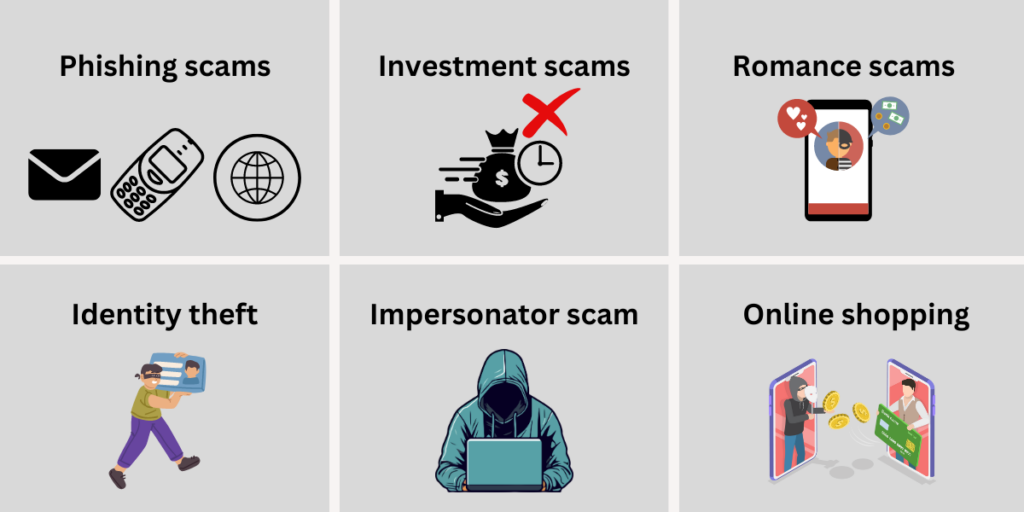Scam Awareness Week 2024: Share a story, Stop a Scam
According to Scamwatch, in the first half of 2024, Australians reported losing over $134 million to scams. While this represents a 52.8% decrease from the same period in 2023, the impact of scams remains significant. Many Australians are becoming better at spotting scams, but certain groups are still disproportionately affected. For example, people aged 55 and over reported 52,797 scam cases, which accounted for 47.6% of total financial losses. Additionally, people with disabilities reported 11,365 scams, accounting for 6.0% of losses.
Investment scams are particularly devastating. In 2023 alone, Scamwatch received over 8,000 reports of investment scams, with losses totalling $292 million. This accounted for more than 60% of all financial losses reported.
As Scam Awareness Week begins, the focus is on raising awareness about these dangers and empowering people to protect themselves. The theme, “Share a Story, Stop a Scam,” highlights the importance of community involvement. By sharing our experiences and reporting scams to platforms like Scamwatch, we can help others avoid falling into the same traps.
The power of sharing: real stories from scam victims
Scams cause financial losses and leave lasting emotional and psychological impacts. By sharing their experiences, victims can help others avoid the same pitfalls. Here are two real-life stories that highlight the importance of awareness and vigilance.

Lisa’s story (Phishing Scam)
Lisa, a 62-year-old retiree from Melbourne, was enjoying her morning coffee when she received an alarming email. The message claimed to be from her bank, warning that her account had been compromised. The email was meticulously crafted, with the bank’s logo and a sense of urgency that made it seem legitimate. The message urged her to verify her identity by clicking on a link.
Worried about her savings, Lisa clicked the link, which redirected her to what appeared to be the bank’s login page. Without thinking twice, she entered her username and password. Moments later, she received a notification that $10,000 had been transferred from her account. In panic, Lisa contacted her bank, only to learn she had been the victim of a phishing scam.
The scammers had created a fake website that mirrored her bank’s login page. When Lisa realised it was a scam, it was too late to recover her money. Determined to prevent others from falling into the same trap, Lisa shared her experience on social media and with her local community group. Her story raised awareness about phishing scams, helping others recognise the warning signs before it was too late.
John’s story (Investment Scam)
John, a 58-year-old small business owner from Brisbane, was approached online by someone claiming to be a financial advisor. This person contacted him through LinkedIn, presenting himself as a seasoned professional with a solid track record in cryptocurrency investments. With a polished profile and numerous connections, the advisor seemed credible.
Intrigued by the promise of high returns, John engaged in several conversations with the advisor, who provided detailed information about a new cryptocurrency opportunity. The advisor even shared fake testimonials from supposed investors who had doubled their money in just a few months. Feeling confident, John invested $50,000, hoping to grow his savings.
A few weeks later, when John tried to withdraw some of his profits, he discovered that the website he had been using to manage his investment was gone. The advisor was no longer responding to messages. John had been scammed, losing his entire investment. He later learned that the testimonials were fake and the advisor was part of a sophisticated network of scammers targeting small business owners.
Devastated but determined to warn others, John shared his story on LinkedIn and with local business networks. His experience served as a stark reminder that even seasoned professionals can fall victim to investment scams.
Why It’s important to report and share scam stories
Awareness: Sharing stories raises awareness, helping others recognise and avoid similar scams.
Prevention: Reporting scams to Scamwatch helps track and stop scammers, preventing them from targeting others.
Empowerment: Victims often feel ashamed or isolated, but sharing their stories can empower them and others to take action and protect themselves.
Understanding the types of scams in Australia
Scams come in many forms, and knowing the different types can help you stay vigilant. In Australia, some scams are particularly prevalent and have caused significant financial harm. Here’s a look at the most common types of scams, how they reach you, and their impact on the community. To understand and know how Impersonation scams operate, read our blog here.

Phishing scams:
Phishing scams remain one of the most widespread methods used by scammers. These scams typically involve fraudulent emails, text messages, or websites that impersonate legitimate organisations, such as banks or government agencies, to trick you into providing personal information.
How they reach you:
Phishing attempts usually arrive via email, claiming urgent issues with your accounts. Scammers may also use SMS (known as “smishing”) or phone calls (“vishing”) to reach potential victims.
The messages often include links to fake websites that steal your login credentials, banking information, or other sensitive details.
Impact:
Phishing is a leading cause of identity theft. Scammers use stolen information to commit further fraud, such as taking out loans or making unauthorised purchases in your name. This type of scam is so prevalent that it consistently ranks among the top-reported scams in Australia.
Investment scams:
Investment scams are particularly damaging, with scammers convincing victims to invest in fake opportunities. These scams often target people looking to make quick, substantial returns, using high-pressure tactics and promising high rewards with little risk.
How they reach you:
These scams are often promoted through social media, online ads, or direct messages on platforms like LinkedIn. Scammers might pose as financial advisors or use fake investment websites that mimic legitimate firms.
Once victims invest, they often find that the scammers disappear along with their money when they try to withdraw their funds.
Impact:
In 2023, investment scams accounted for over 60% of all financial losses reported to Scamwatch, with Australians losing a staggering $292 million. The severity of these losses led to the creation of a Fusion Cell, a collaborative effort between government and industry leaders to address and mitigate the harm caused by these scams.
Romance scams:
Romance scams are particularly cruel, as they exploit people’s emotional vulnerabilities. Scammers build relationships with their victims over time, using fake profiles on dating sites or social media to gain trust before eventually asking for money.
How they reach you:
Scammers typically initiate contact through dating apps or social media platforms. They may spend weeks or months establishing a rapport before making a financial request, often framed as an urgent need such as a medical emergency or travel expenses.
These requests are usually small at first but can quickly escalate, with victims often sending large sums of money.
Impact:
Beyond the significant financial losses, romance scams cause deep emotional pain. Victims often feel betrayed and ashamed, making them less likely to report the fraud or seek help. Despite this, romance scams continue to be one of Australia’s most reported types of fraud.

Identity theft: A growing concern in Australia
Identity theft is one of the most insidious and damaging types of fraud. Scammers steal personal information to commit crimes in someone else’s name. This can include opening bank accounts, taking out loans, or making unauthorised purchases. The victim remains unaware until it’s too late. In Australia, identity theft has become a significant concern, with thousands of Australians falling victim each year.
How identity theft occurs:
Identity theft often begins with the theft of personal information, such as names, addresses, birth dates, bank account numbers, and even social security numbers. Scammers use a variety of methods to obtain this information:
–Phishing scams: As one of the most common methods, phishing involves tricking individuals into providing personal details through fake emails, texts, or websites that appear legitimate.
–Data breaches: Large-scale data breaches at businesses or government agencies can expose sensitive information.
–Social engineering: Scammers manipulate victims into revealing personal information by pretending to be someone they trust, such as a bank representative or government official.
–Mail theft: Physical mail that contains sensitive information, like bank statements or tax returns, can be stolen from mailboxes.
You can visit Scamwatch and IDCARE, Australia’s national identity and cyber support service, for more detailed information and resources.
Conclusion: Staying vigilant in a complex scam landscape
Scams target individuals and exploit legitimate services like remittance companies to launder stolen money. Identity thieves often open accounts with remittance companies using stolen personal information to move illicit funds across borders. This makes it essential for both consumers and remittance companies to be vigilant.
Customers must regularly monitor their accounts and be cautious with their personal information. If something seems off, report it immediately. Remittance companies like Rocket Remit implement strict security measures and closely monitor transactions to prevent scammers from misusing their services.
By working together—customers staying alert and companies enforcing robust security practices—we can make it much harder for scammers to exploit the system. Protecting your identity and your money is a shared responsibility that benefits everyone.
About Rocket Remit
Rocket Remit is the world’s fastest international money transfer service. Send money instantly to over 60 overseas countries at very competitive rates.
Use the country selector to choose the country and check the rate.
Click here for more information on how to send money using Rocket Remit.
Download the Rocket Remit app from Google Play or the Apple Store